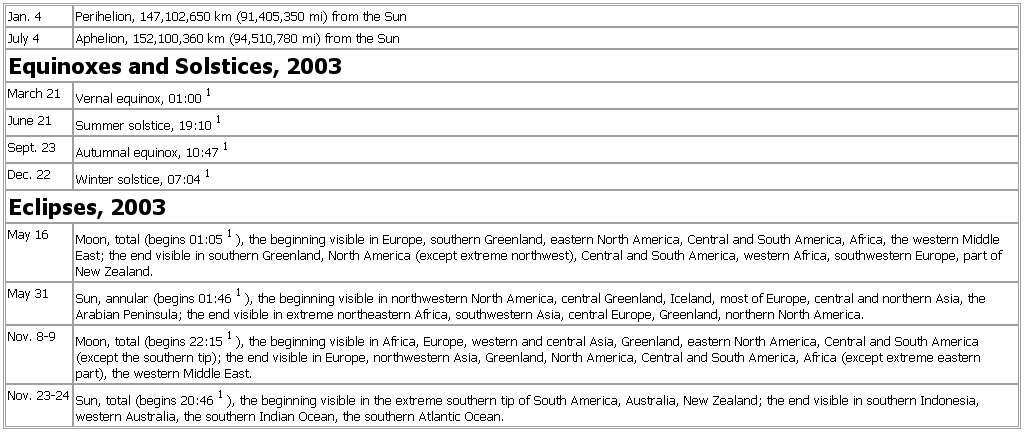Earth Perihelion and Aphelion, 2003
- Earth Perihelion and Aphelion, 2003
-
Jan. 4 Perihelion, 147,102,650 km (91,405,350 mi) from the Sun
July 4 Aphelion, 152,100,360 km (94,510,780 mi) from the Sun
Equinoxes and Solstices, 2003
March 21 Vernal equinox, 01:001
June 21 Summer solstice, 19:101
Sept. 23 Autumnal equinox, 10:471
Dec. 22 Winter solstice, 07:041
Eclipses, 2003
May 16 Moon,
total (
begins 01:051),
the beginning visible in Europe,
southern Greenland,
eastern North America,
Central and South America,
Africa,
the western Middle East;
the end visible in southern Greenland,
North America (
except extreme northwest),
Central and South America,
western Africa,
southwestern Europe,
part of New Zealand.
May 31 Sun,
annular (
begins 01:461),
the beginning visible in northwestern North America,
central Greenland,
Iceland,
most of Europe,
central and northern Asia,
the Arabian Peninsula;
the end visible in extreme northeastern Africa,
southwestern Asia,
central Europe,
Greenland,
northern North America.
Nov.
8-
9 Moon,
total (
begins 22:151),
the beginning visible in Africa,
Europe,
western and central Asia,
Greenland,
eastern North America,
Central and South America (
except the southern tip);
the end visible in Europe,
northwestern Asia,
Greenland,
North America,
Central and South America,
Africa (
except extreme eastern part),
the western Middle East.
Nov.
23-
24 Sun,
total (
begins 20:461),
the beginning visible in the extreme southern tip of South America,
Australia,
New Zealand;
the end visible in southern Indonesia,
western Australia,
the southern Indian Ocean,
the southern Atlantic Ocean.
See as table:
1Universal time.
Source: The Astronomical Almanac for the Year 2003 (2002).
* * *
Universalium.
2010.
Look at other dictionaries:
Earth Perihelion and Aphelion, 2004 — ▪ Table Jan. 4 Perihelion, 147,098,250 km (91,402,620 mi) from the Sun July 5 Aphelion, 152,098,990 km (94,510,000 mi) from the Sun Equinoxes and Solstices, 2004 March 20 Vernal equinox, 06:491 June 21 Summer solstice, 00:571 Sept. 22 Autumnal… … Universalium
Mathematics and Physical Sciences — ▪ 2003 Introduction Mathematics Mathematics in 2002 was marked by two discoveries in number theory. The first may have practical implications; the second satisfied a 150 year old curiosity. Computer scientist Manindra Agrawal of the… … Universalium
Earth — This article is about the planet. For other uses, see Earth (disambiguation). Earth … Wikipedia
2003 YN107 — Infobox Planet | discovery=yes | physical characteristics = yes | bgcolour=#FFFFC0 name=mp|2003 YN|107 discoverer=LINEAR discovered=December 20, 2003 alt names= none mp category=Aten epoch=October 22, 2004 (JD 2453300.5) semimajor=149.212 Gm… … Wikipedia
2003 QQ47 — Infobox Planet | discovery=yes | physical characteristics = yes | bgcolour=#FFFFC0 name=2003 QQ47 discoverer=LINEAR discovered=August 24, 2003 alt names= none mp category=Apollo asteroid epoch=October 22, 2004 (JD 2453300.5) semimajor=162.380 Gm… … Wikipedia
2003 AZ84 — Infobox Planet bgcolour = #FFFFC0 name = mp|2003 AZ|84 symbol = caption = discovery = yes discoverer = C. Trujillo, M. Brown, E. Helin, S. Pravdo, K. Lawrence, and M. Hicks discovered = January 13, 2003 mp name = mp|2003 AZ|84 alt names = none mp … Wikipedia
Near-Earth object — Asteroid 4179 Toutatis is a potentially hazardous object that has passed within 2.3 lunar distances … Wikipedia
Physical Sciences — ▪ 2009 Introduction Scientists discovered a new family of superconducting materials and obtained unique images of individual hydrogen atoms and of a multiple exoplanet system. Europe completed the Large Hadron Collider, and China and India took… … Universalium
Near-Earth asteroid — Near Earth asteroids (NEAs) are asteroids whose orbits are close to Earth s orbit. All near Earth asteroids spend part of their orbits between 0.983 and 1.3 astronomical units away from the Sun. Some near Earth asteroids orbits intersect Earth s… … Wikipedia
(84922) 2003 VS2 — Infobox Planet bgcolour=#FFFFC0 name=mp|(84922) 2003 VS|2 discovery=yes discovery ref= discoverer= NEAT discovered=November 14, 2003 mp name=mp|(84922) 2003 VS|2 alt names= none mp category=Plutinocite web date=2006 Dec. 21 title=MPEC 2006 X45 :… … Wikipedia
 1Universal time.Source: The Astronomical Almanac for the Year 2003 (2002).
1Universal time.Source: The Astronomical Almanac for the Year 2003 (2002).